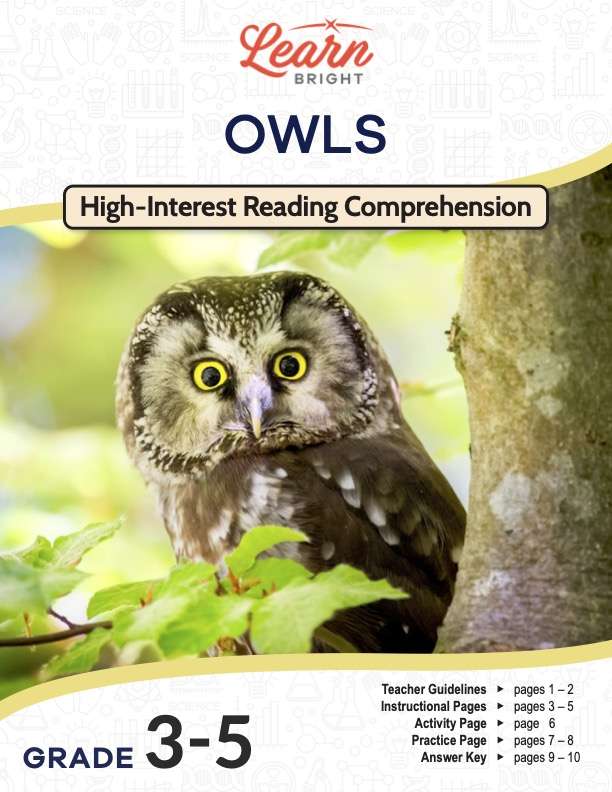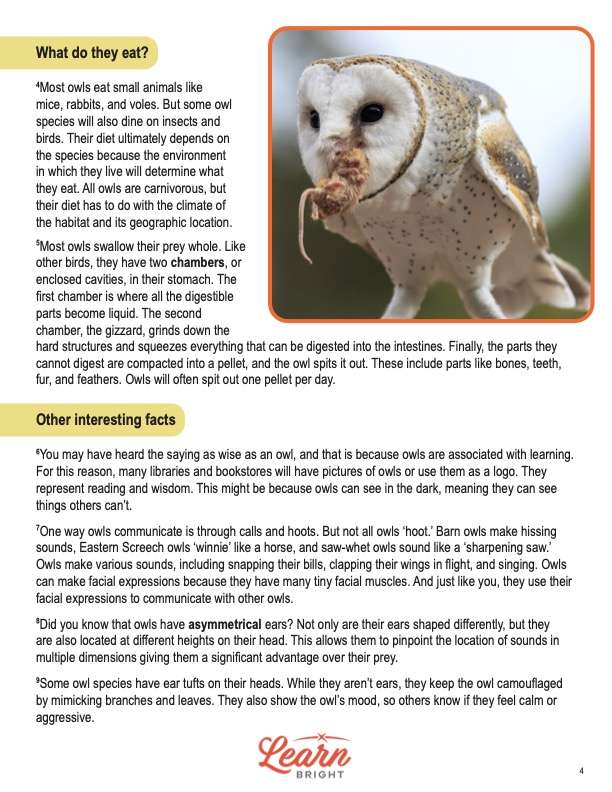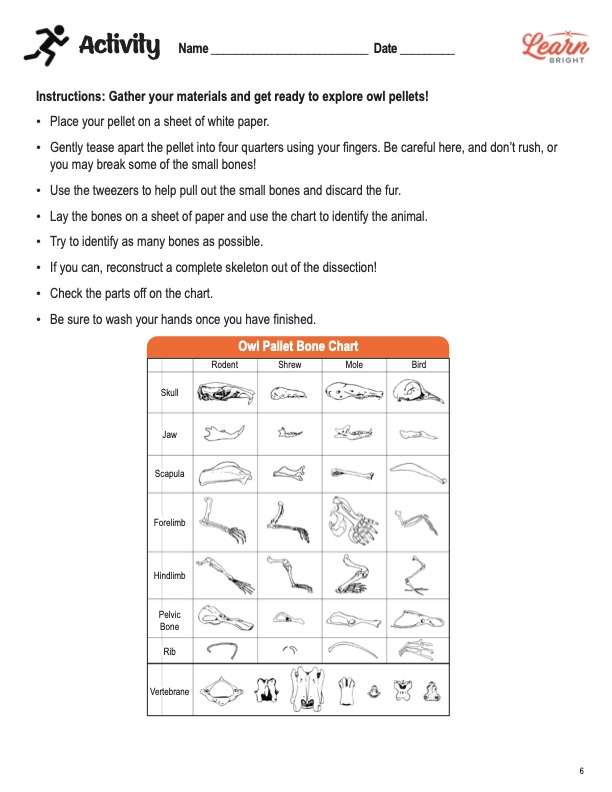Description
What our Owls lesson plan includes
Lesson Objectives and Overview: Owls is a high-interest reading comprehension lesson plan. As such, students will practice various close reading and comprehension skills. In addition, they will learn about the habitat, diet, and behaviors of these nocturnal birds. This lesson is for students in 3rd grade, 4th grade, and 5th grade.
Classroom Procedure
Every lesson plan provides you with a classroom procedure page that outlines a step-by-step guide to follow. You do not have to follow the guide exactly. The guide helps you organize the lesson and details when to hand out worksheets. It also lists information in the yellow box that you might find useful. You will find the lesson objectives, state standards, and number of class sessions the lesson should take to complete in this area. In addition, it describes the supplies you will need as well as what and how you need to prepare beforehand. For the activity, you will need tweezers, white paper, pellets, and magnifying glasses (optional).
Teacher Notes
The paragraph on this page provides a little more information or guidance on what to expect from the lesson. It explains that you can teach this lesson in a whole-class setting or to an independent, small group as an activity. You can use the blank lines to record any thoughts or ideas you have as you prepare.
OWLS LESSON PLAN CONTENT PAGES
What Is an Owl?
The Owls lesson plan contains three content pages. It begins by providing a box of background information about this animal. This bird lives in forests, mountains, deserts, and plains. Their diet consists of small animals and they can live between 5 and 12 years in the wild.
Owls live around the world in almost every type of habitat. There are two types of owls: barn owls (Tytonidae) with a heart-shaped facial disk and all other owls (Strigidae). All owls look pretty much the same. They have brown, grey, or white feathers with streaks or spots. They have large heads, flat faces, big eyes, hooked beaks, and sharp talons. In addition, owls have short tails, long wings, and impeccable hearing and eyesight.
All owls have an upright posture with their eyes facing forward, just like humans. They cannot move their eyes very much because they are fixed on their head. To obtain depth perception, they have to move their entire head. Their heads turn in a circular motion to get a complete picture of the object. Owls can rotate their necks 270 degrees to look directly backward! And the eyes of an owl are not actual eyeballs. Their tube-shaped eyes help them see their prey from great distances and focus on it. Up close, owls don’t see that well!
Students will learn that an owl is a bird of prey. But unlike other birds of prey, owls are nocturnal, which means they are active at night. In addition, they are zygodactyl [zig-uh-dak-til]. This means they have two forward-facing toes and two backward facing toes on their feet. But what is remarkable is that they can pivot one of their back toes forward to help them grip and walk.
What They Eat
Most owls eat small animals like mice, rabbits, and voles. Some owl species will also dine on insects and birds. Their diet ultimately depends on the species because the environment in which they live will determine what they eat. All owls are carnivorous, and their diet has to do with the climate of the habitat and its geographic location.
Most owls swallow their prey whole. Like other birds, they have two chambers, or enclosed cavities, in their stomach. The first chamber is where all the digestible parts become liquid. The second chamber—the gizzard—grinds down the hard structures and squeezes everything that can be digested into the intestines. Finally, the parts they cannot digest are compacted into a pellet, and the owl spits it out. These include parts like bones, teeth, fur, and feathers. Owls will often spit out one pellet per day.
Other Interesting Facts
You may have heard the saying “as wise as an owl,” and that is because people associate owls with learning. For this reason, many libraries and bookstores will have pictures of owls or use them as a logo. They represent reading and wisdom. This might be because owls can see in the dark, meaning they can see things others can’t.
One way owls communicate is through calls and hoots. But they don’t all hoot. Barn owls make hissing sounds, Eastern screech owls whinny like a horse, and saw-whet owls sound like a sharpening saw. Owls make various sounds, including snapping their bills, clapping their wings in flight, and singing. They can also make facial expressions because they have many tiny facial muscles. And just like you, they use their facial expressions to communicate with other owls.
Did you know that owls have asymmetrical ears? Not only are their ears shaped differently, but they are also located at different heights on their head. This allows them to pinpoint the location of sounds in multiple dimensions, giving them a significant advantage over their prey.
Some species have ear tufts on their heads. While they aren’t ears, they keep the owl camouflaged by mimicking branches and leaves. They also show the owl’s mood so others know whether it feels calm or aggressive.
Why Owls Are Important
These incredible birds play a huge role in balancing the food web in many forests worldwide. Barn owls eat up to 11,000 rodents in 10 years, which helps farmers because those rodents would gobble up many of their crops. Owls also attract tourists to certain areas. Birdwatchers want to spot these elusive and mysterious predators, so they spend money to come to places where owls live.
While they are not endangered, owls do face dangers. For example, they are often displaced by habitat loss. In addition, chemicals like pesticides can make owls very sick. With so many cars and trucks on the road at night, they have also been known to run into vehicles. Each of these have impacted owls differently and sent several owl species into decline.
OWLS LESSON PLAN WORKSHEETS
The Owls lesson plan includes two worksheets: an activity worksheet and a practice worksheet. Each one will help students solidify their grasp of the material they learned throughout the lesson. You can refer to the classroom procedure guidelines to know when to hand out each worksheet.
OWL PELLETS ACTIVITY WORKSHEET
Students will get to find bones in owl pellets for the activity! Each team of students will use the supplies you provide to dissect their pellets. They will first place the pellet on a sheet of white paper. They will gently break apart the pellet into four quarters using their fingers. Using the tweezers, students will pull out the small bones and discard any fur. The goal is to match the bones they find with the chart on the bottom of the worksheet. If they can, students can try to reconstruct a complete skeleton out of the dissected pellet.
CONTENT REVIEW PRACTICE WORKSHEET
The practice worksheet lists 11 questions based on the content. These questions all relate to the content pages, so students will need to refer to them often for the answers. In addition, each question provides which reading tool the question corresponds to, such as text feature, vocabulary, or comprehension.
Worksheet Answer Keys
At the end of the lesson plan document is an answer key for the practice worksheet. The correct answers are all in red to make it easier for you to compare them with students’ responses. If you choose to administer the lesson pages to your students via PDF, you will need to save a new file that omits these pages. Otherwise, you can simply print out the applicable pages and keep these as reference for yourself when grading assignments.










